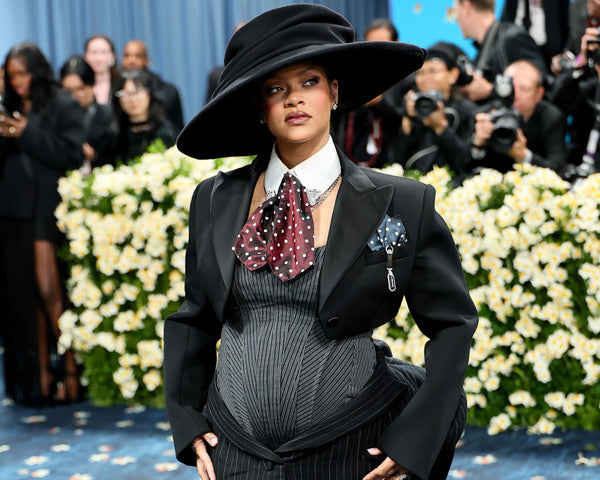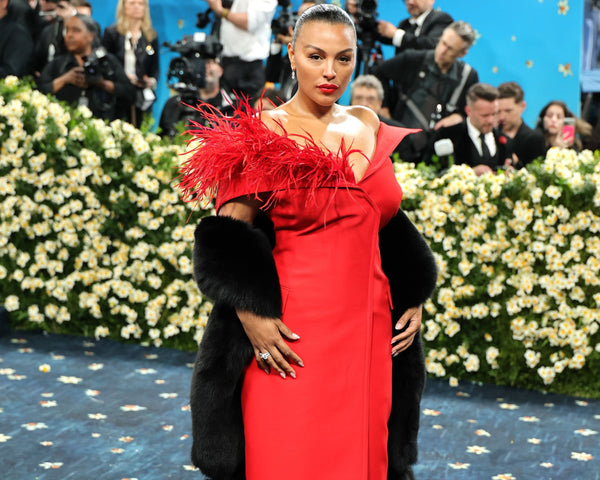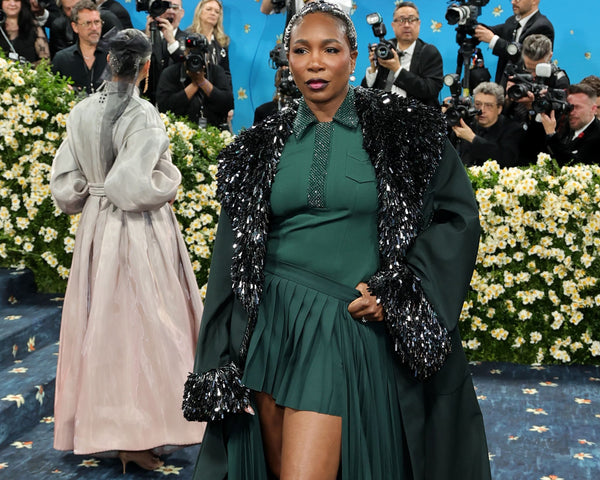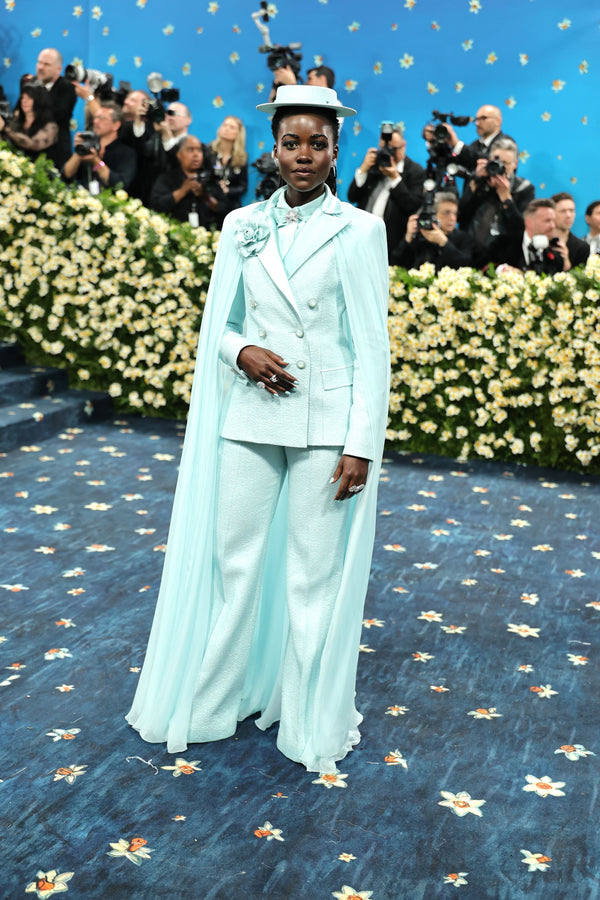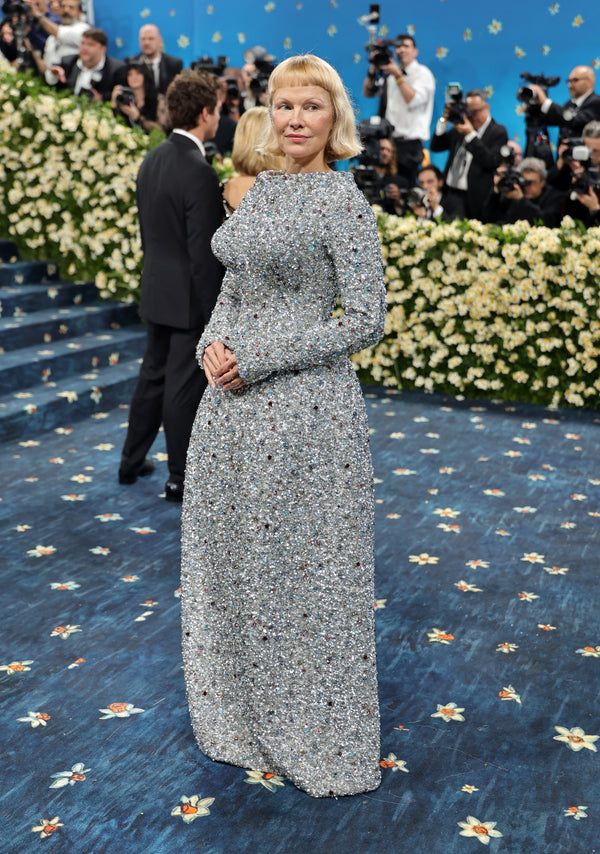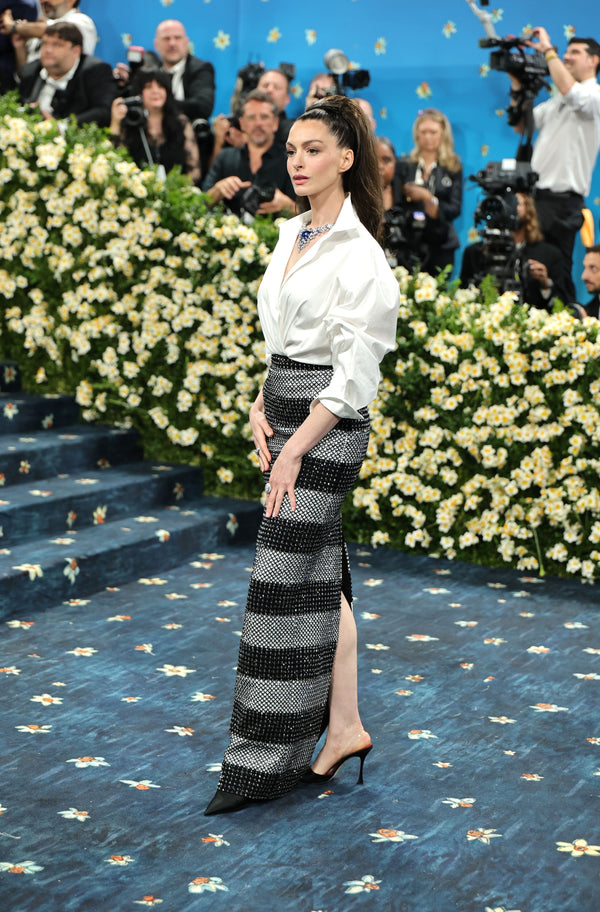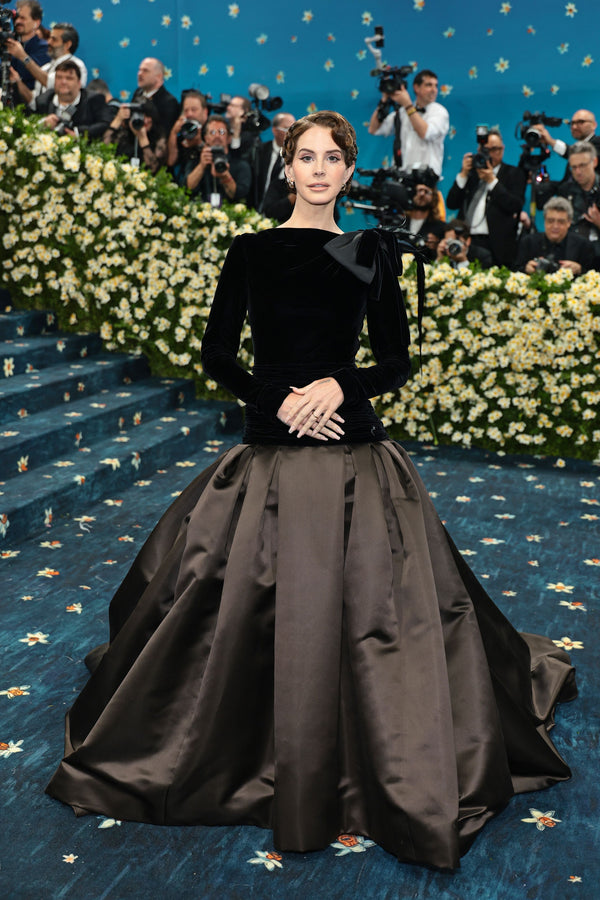Whether you consider yourself a classic, modern or more alternative bride, there’s a wedding look for you to ensure you feel magnificent on your wedding day. If you want a timeless or modern fairy tale dress, sculptural bridal separates that can be styled in different ways for endless mileage, a statement making non-traditional ivory jumpsuit or cool perfectly cut two-piece wedding suit that you can enjoy for years to come, selecting your bridal garment and fabric is a big part of the planning process. With so many styles to choose from and keeping in mind the wedding destination, time of year, the venue, guest dress code, the budget and so much more, selecting your wedding garment (and suitable fabric) to celebrate your big day and personal style, can feel like a lot of pressure, and it should be fun!
 A stunning lace Bridal dress by Liz Martinez.
A stunning lace Bridal dress by Liz Martinez.
So before you go on the hunt and fall in love with bridal fabrics to create your desired look, talk to your dressmaker, discuss the type of day you would like to have, the style of wedding garment you want to achieve, your body shape - the features you want to flaunt and those you would prefer to hide - don't forget the back of the dress is as important as the front, especially when it comes to photos! You will need to understand the style, drape and structure of the wedding fabric - which will cling to your curves or flatter them; fall softly and sways smoothly as you dance the night away, or hold and remain crease-free during a formal sit-down dinner. You need to think about whether you would be more comfortable wearing a bias cut silk, draping over your curves or more comfortable in a thicker, supportive crepé, duchess satin or lace fabric.
Selecting your bridal fabrics and what to consider:
Fabric Drape
Fluid drape fabrics with little structure - Fabrics with a fluid drape are very flowy, hang straight down and cling to your body. Fluid drape fabrics include silk satin, chiffon, georgette, crepe de chine, microfibre, and viscose, they are ideal to create garments that are flowy or gathered and can be used for dresses, skirts, bridal tops and flower girl outfits.
Moderate drape fabrics with average structure - Moderate drape fabrics are more versatile than fluid drape fabrics. Moderate drape fabrics gently skim the body but don’t stand away from the body like low drape fabrics. Moderate drape fabrics are not soft or crisp, but do range in their fluidity. They include chantilly lace, chiffon and stretch satin and can be used to create dresses, modern bridal skirts & tops and capes.
Low drape fabrics offer a lot of structure - Low drape, full bodied fabrics are stiff and stand away from the body. They hold pleats and soft folds well, making them ideal to create flattering, structured garments for your special day. Low drape fabrics include dupioni silk, 4-ply crêpe, taffeta, faille, Mikado/zibeline, shantung, duchess satin and Guipure lace fabrics. They are ideal to create structured dresses, modern skirts and tops, bridal jumpsuits and two-piece tuxedo suits.

Visit our Joel & Son Fabrics store to view our huge selection of bridal fabrics.
The bridal fabrics we love and why we love them!
Silk
Silk is undoubtedly the most popular and admired fabric to create your dream wedding garment. Pure silk cloth is luxurious, soft and lightweight, drapes beautifully and has resilience, (elasticity if elastane has been added), strength and durability. There are also many options of silk fabrics to choose from.
Silk Crêpe

A beautiful and simple silk crêpe wedding dress.
Made of a soft silk or lightweight rayon, crêpe is gauzy and crinkled fabric, perfect for soft silhouettes. The shapely fabric can be great for accentuating curves but also works well in stark, minimalist designs that can be worn all year-round.
Pros: Soft, comfortable fabric that doesn't wrinkle easily if its good quality. Cons: Needs to be lined otherwise is unforgiving. Ideal for: For minimalist style design. A-line or fit-and-flare silhouette style dresses or bridal jumpsuits.
Silk Chiffon

A flowy silk chiffon wedding dress.
Due to its lightness and transparency, chiffon is often used in layers or as an overlay. Made from woven silk, this breathable sheer, matte fabric has a beautiful drape and creates a floaty and ethereal look ideal for photos of your dress blowing in the wind. It’s light and airy structure make chiffon fabric a great choice for summer weddings.
Pros: Smooth and comfortable, travels well and doesn't wrinkle easily. Cons: Needs to be lined, delicate fabric can be quite fragile, easily snagging or pulling. Ideal for: Glamorous or sexy sheath silhouette wedding dresses, romantic goddess or a more whimsical bohemian style bridal garments.
Duchess Satin

A duchess satin wedding gown.
Luxurious and suitable for the cooler months, duchess satin is a classic fabric which is extremely comfortable to wear making this fabric very popular for weddings. This material can be very supportive, lending itself to an elegant and structured wedding garment that outlines the female figure and is ideal to create a bodice, it does however wrinkle.
Pros: Smooth and comfortable, photographs well and has a natural sheen. Cons: Can feel warm and creases need to be carefully steamed. Ideal for: Works with just about every silhouette and can be used for A-line, ballgown or fit-and-flare style wedding dresses. Duchess satin fabric is also great for less traditional wedding garments including fuller box pleat wedding skirts with box-shaped wedding tops, jumpsuits and or two-piece bridal suits.
Silk Satin

A sexy silk satin wedding dress.
One of the more traditional wedding fabrics, silk satin fabric has a weight that is suitable for all seasons. This flattering fabric has a smooth and lustrous appearance with a fluid drape. Silk satin will photograph better if it's not pure white.
Pros: Smooth and comfortable, photographs well and has a natural sheen. Cons: Can feel warm and creases need to be carefully steamed. Ideal for: Silk satin can be used for almost all wedding silhouettes to create traditional and modern wedding dresses and versatile bridal separates including bustier style tops.
Silk Tulle

A romantic silk tulle wedding dress.
Sheer and gauzy, tulle fabrics resemble very fine netting. It is very delicate and can be ruched if needed to add structure. It creates volume without being heavy and is also ideal barely there illusion style necklines, open backs, cut outs and bridal veils.
Pros: It doesn't wrinkle easily (and a little steam does miracles), keeps it shape. Cons: Needs to be adjusted for photos, is delicate and can snag or tear. Ideal for: Romantic style flowy wedding dresses, flowy skirts, soft veils, pretty flower girl dresses and flowy modern wedding separates.
Organza

A feminine silk organza wedding dress.
Lightweight and sheer, organza fabrics can be used for sculptural or flowy silhouettes. It's traditionally woven from silk, but can also include synthetic fibers. Organza has a slightly shiny finish and an exceptional, crisp structured drape - it is often used for dreamy layered gowns to add fullness or for trains, and veils due to its lightness making it ideal for warmer weather weddings.
Pros: Light and breathable fabric, holds more shape and volume. Travels well, and requires considerable steam to remove creases.
Cons: Organza is a delicate fabric and is prone to creasing, snags and pulls.
Ideal for: Whimsical and frothy looks, this sheer material is the epitome of romantic and feminine nuptial celebrations.
Shantung

A classic shantung wedding gown.
Plainly woven silk shantung features a subtle weave that creates an irregular surface texture. This raw and natural look fabric has a slight shimmer and is mid weight making it appropriate for all seasons. Shantung fabric looks rich, has a stiff drape and holds its shape making it ideal for tailored garments - it has a beautiful drape and is flattering for most body shapes.
Pros: Fairly lightweight fabric, it keeps its volume without needing lots of crinoline. Cons: It wrinkles easily and some brides don’t like the ‘raw’ look. Ideal for: A-line, column or ball gown style bridal dresses
Taffeta

A statement taffeta wedding gown.
Taffeta can be made from silk or synthetic fibers. The stiffer the taffeta, the higher its quality and the better its shape retention. This high-end crisp fabric is versatile and suitable for both winter and summer weddings because of its moderate weight. Taffeta has a gorgeous lustrous shiny appearance and is a supple fabric.
Pros: Luxurious, pliable and creates beautiful silhouettes. Taffeta doesn’t pill. Cons: Does not have any stretch due to the stiffness of the fabric, makes a rustling sound when moving. Ideal for: A-line dresses, fit-and-flare or ball gown style wedding dresses and full skirts.
Lace

A dramatic lace wedding dress.
Lace fabric adds a feminine touch to any wedding garment and when overlaid with another bridal fabric can look simply stunning especially when you forgo the traditional color scheme and opt for an unexpected and enchanting powder pink or a soft pale silvery-grey for example. With endless options, delicate Chantilly lace, heavier Giupure or corded lace, plain, faux-pearl or Swarovski embellished lace or metallic lace can be used for a sophisticated traditional or modern wedding garment.
Pros: Used across many cultures, so much variety to choose from including plain and embellished, it pairs well with many other fabrics and doesn't wrinkle easily. Cons: Poor quality lace can be scratchy, it can snag or pull and doesn’t usually have a lot of stretch. Ideal for: Romantic or modern style fitted, A-line or ball gown wedding dresses, modern wedding separates, Tuxedo jackets, bodices and veils.
Brocade

A fairytale brocade wedding dress.
Brocade fabric is an elegant medium weight cloth that has an elaborately embroidered surface weave. Often used for more traditional wedding garments, brocade is suited for the cooler months as it retains heat. Brocade fabric t is strong, has body and is a little stiff, making it perfect for structured bridal garments which are generally flattering. Brocade fabric can be lighter and softer or stiffer and thicker than satin and often worn in Indian and Chinese cultural or countryside weddings.
Pros: Sturdy fabric that keeps its shape. Cons: Doesn’t have much stretch and best to be dry cleaned. Ideal for: A-line, column gowns, sheath dresses and structured bridal garments, two-piece suits and bridal skirts.
Velvet

A timeless velvet wedding dress.
Velvet is soft and thick making it suitable for a wedding during the cooler months. This tactile and luxurious fabric is ideal for a regal or vintage inspired look. Silk velvet is especially soft and has a lovely appearance, drape and handle. Velvet fabric also looks great combined with white faux fur for a luxe winter wedding.
Pros: Soft plush texture and looks luxurious. Cons: More difficult to clean than other fabrics, can wear out with high use. Ideal for: Capes, shrugs, A-line and sheath style bridal or bridesmaid dresses, long sweeping skirts.
Mikado or Zibeline

A classice mikado wedding dress.
Zibeline is woven in a single direction from straight fibers for a shiny finish. Silk zibeline is the most common variety used in wedding dresses. The constructed fabric.
Pros: Easier to steam & keep from wrinkling, tends to be stiffer and holds volume and structure a little better, but still keeps the shine. Cons: Heavier and hotter than other options. Ideal for: Structured designs like fit-and-flare or A-line bridal garments.
In the never-ending search for the perfect bridal fabric, our Joel & Son Fabric experts are here to help you make the right decision for the most significant clothing purchase you are likely to make. A selection of our wedding fabrics are available online or visit our London store to view the entire range.






















